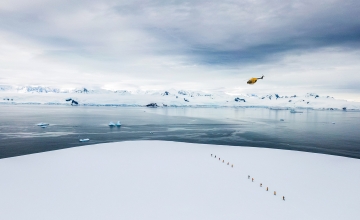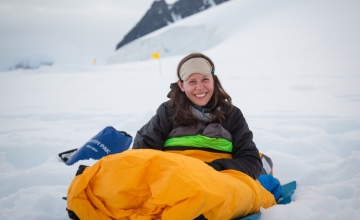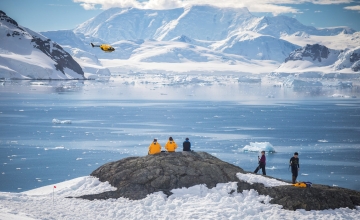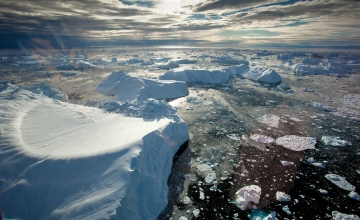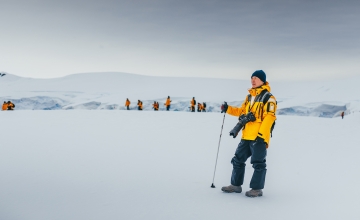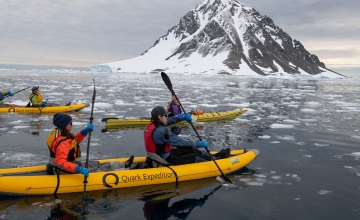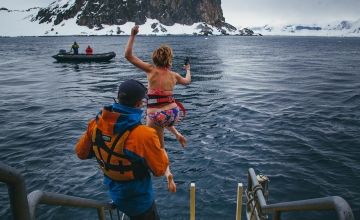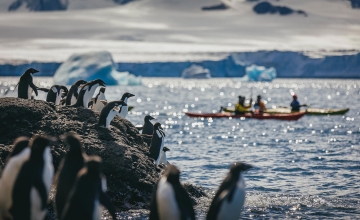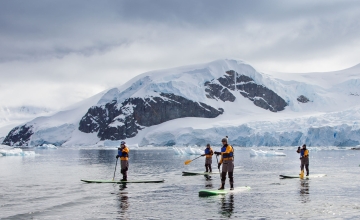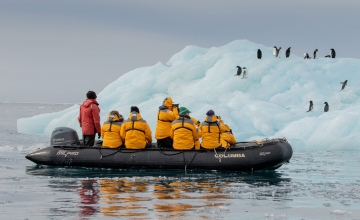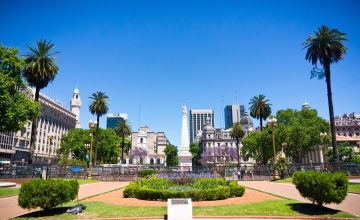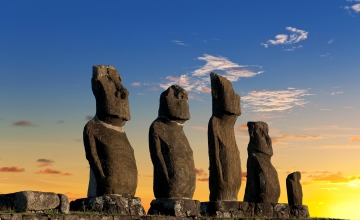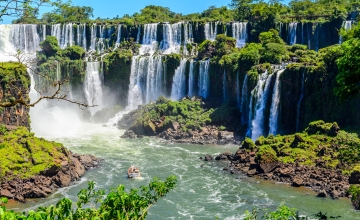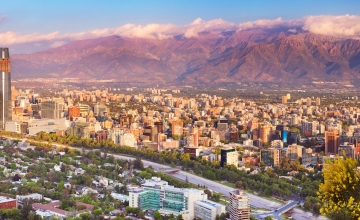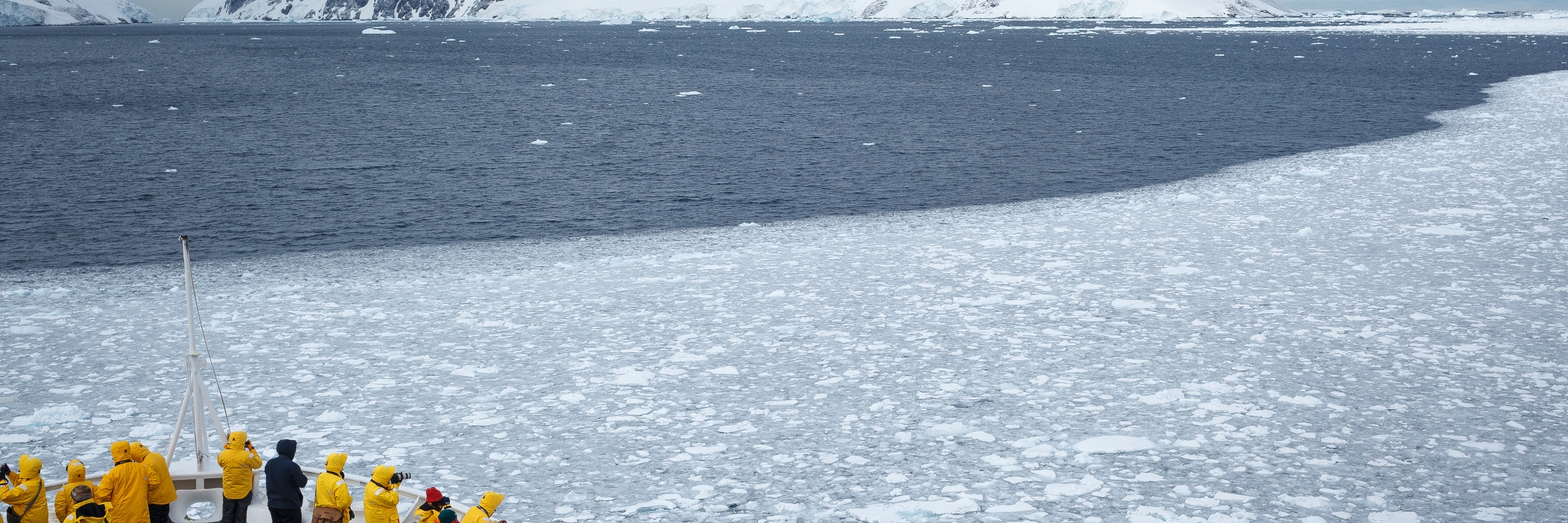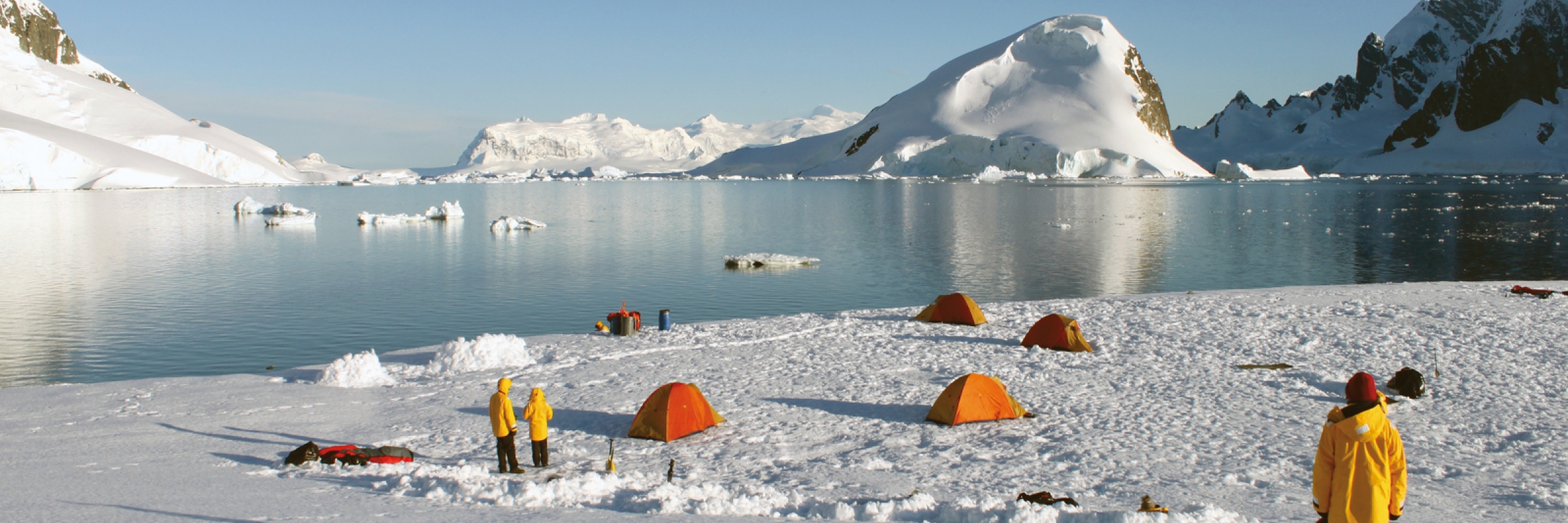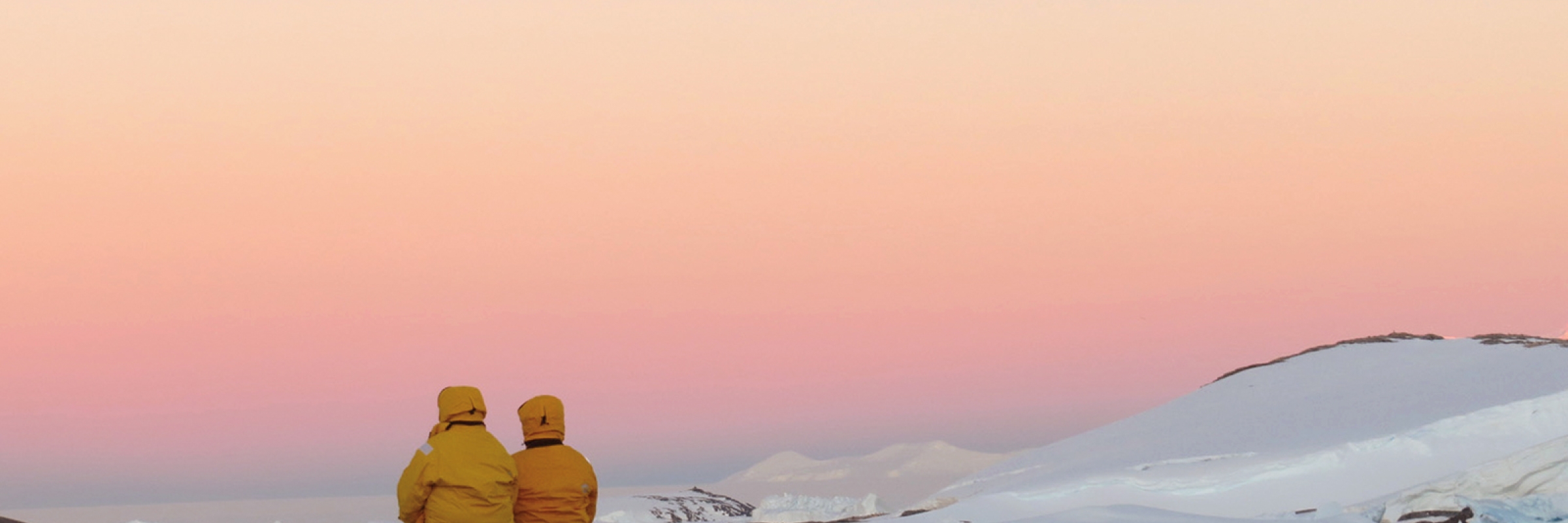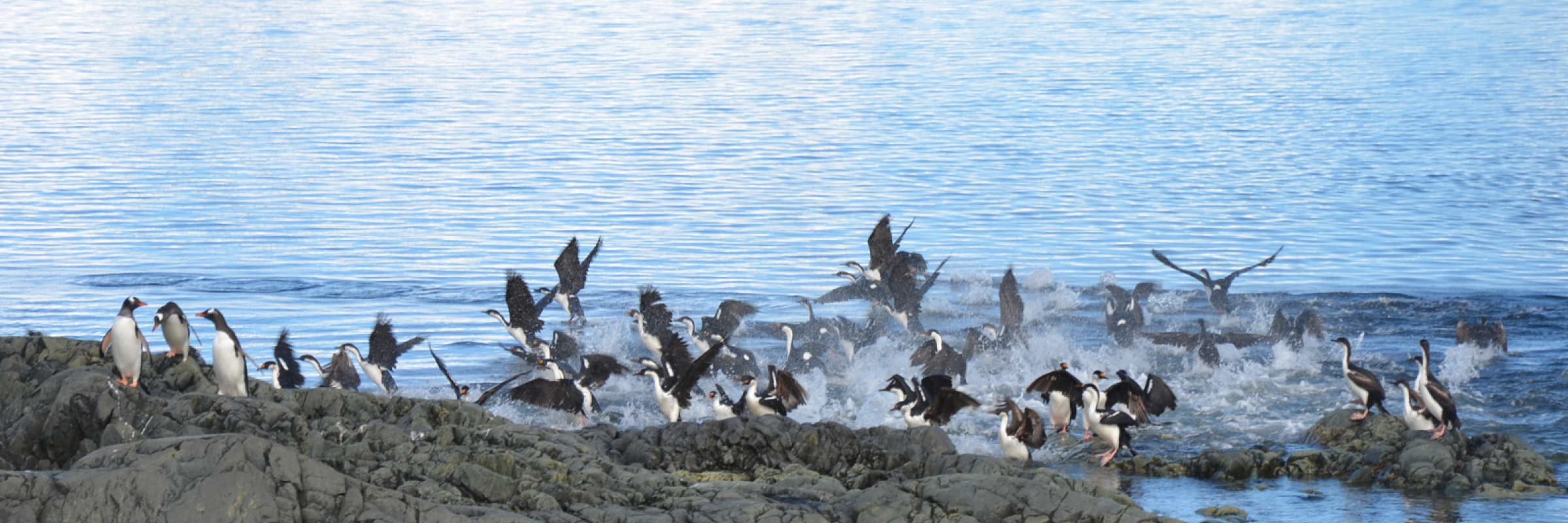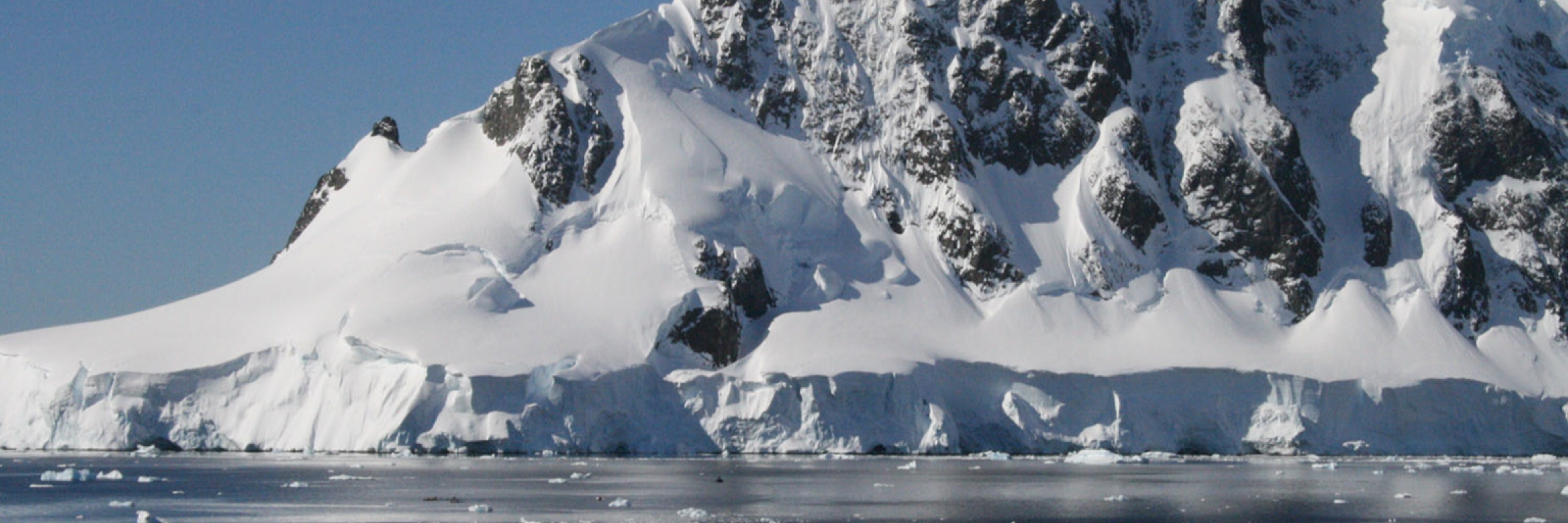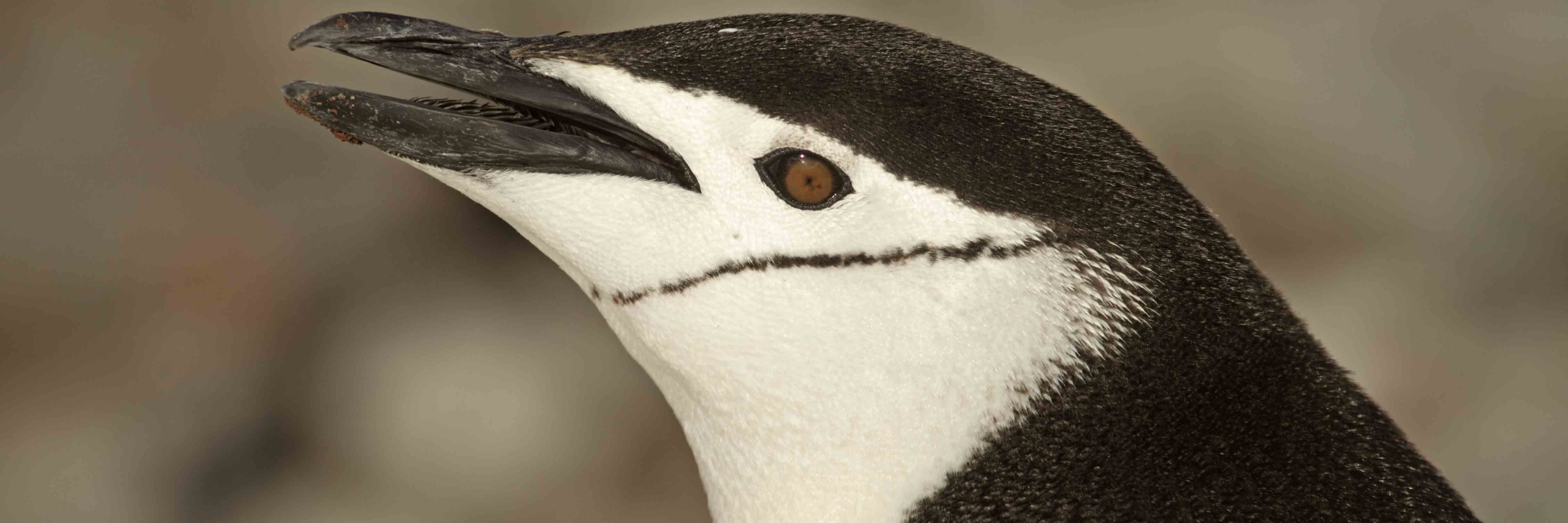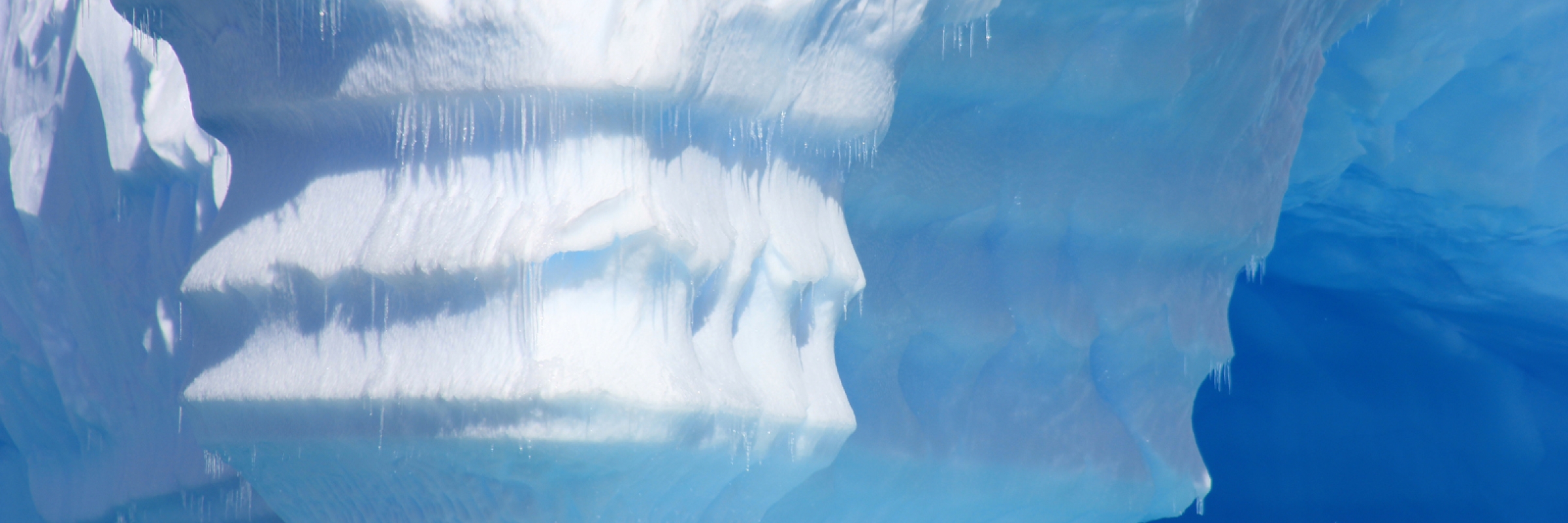You will begin your journey in Ushuaia, a small but bustling port town at the tip of South America. This Argentine town is an ideal gateway for you to explore the southern extent of Patagonia while preparing for your adventure ahead. Get active in the mountains or enjoy handcrafted chocolate at a café in town.
Crossing the Circle: Southern Expedition
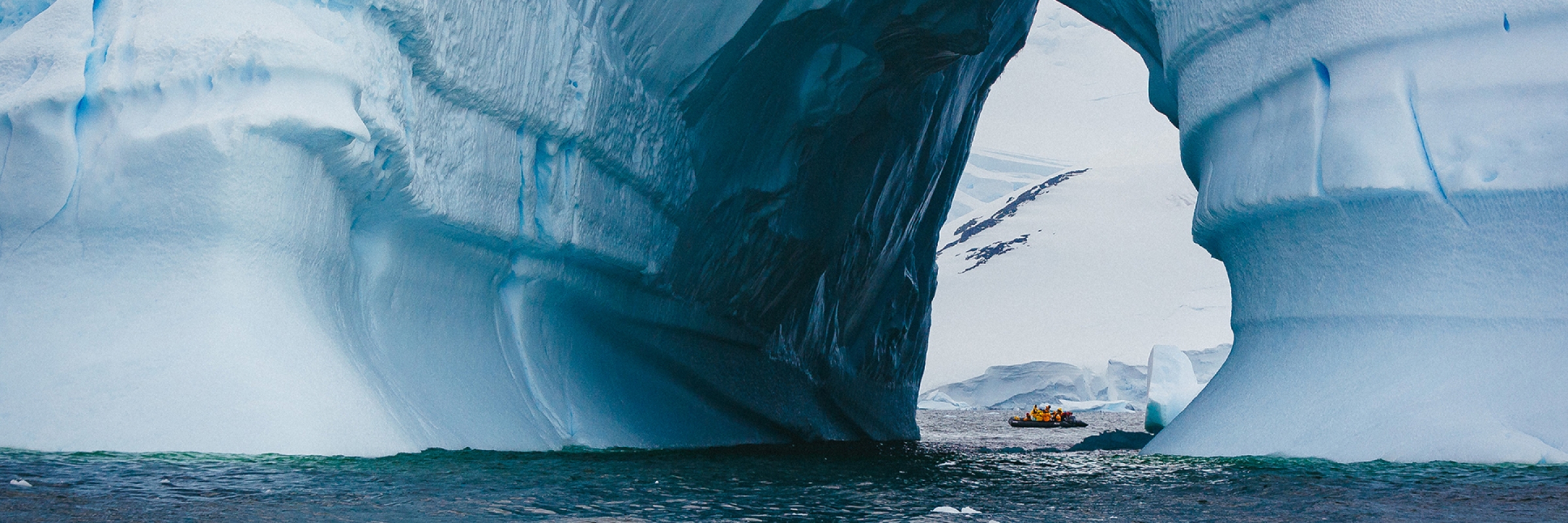
Setting foot on the 7th Continent is a polar achievement relatively few people experience in their lifetime. Even more rare is the incomparable milestone that’s achieved when a traveler crosses the iconic Antarctic Circle. Navigating south of 66°33' S is—for most guests—the highlight of the 14-day itinerary Crossing the Circle: Southern Expedition, which rewards passengers daily with views of dramatic ice formations, humpback whales swimming alongside the ship, leopard seals diving beneath your Zodiac, penguins sliding off icebergs into crystal waters, or giant petrels soaring above the crackling sea.
Starting in 2021, this itinerary allows you to the opportunity to experience our pioneering new vessel, Ultramarine. This purpose-built vessel is designed to extend the boundaries of polar exploration and offer an unmatched Antarctic experience, including a flightseeing tour you’ll never forget and a range of adventure options more extensive than any other ship in its class.
- If you’re travelling onboard Ultramarine in 2021, arrive in Buenos Aires, Argentina and let us take care of the rest of your journey
- Be one of the few travelers to venture to 66°33´
- Visit Antarctic research stations
- Witness abundant Antarctic wildlife, including penguins, seals and whales
- Experience western Antarctic Peninsula highlights and visit iconic landing sites
- Learn about Antarctica’s history, glaciology and wildlife from onboard specialists
- Enjoy helicopter flightseeing if you’re travelling onboard Ultramarine in 2021 and experience a unique perspective of the Antarctic Peninsula
行程
Day 1 — Arrive in Ushuaia, Argentina
Day 2 — Embark
As the ship sets sail in the late afternoon, you will begin your Antarctic journey, passing through the Beagle Channel. Named after the famed ship on which Charles Darwin voyaged, the channel presents great photo opportunities of landscapes and seabirds. Eventually, the channel opens up to the Southern Ocean, and onwards to Antarctica.
Days 3 and 4 — Crossing the Drake Passage
Your days at sea are filled with presentations led by your Expedition Team who will prepare you for the wildlife, glaciology and history that will greet you upon your arrival. In between presentations, spend time on deck looking for wildlife or chatting with your shipmates over a drink at the bar.
Days 5 to 7 — South Shetland Islands and Antarctic Peninsula
The most common reaction upon reaching the White Continent is a sense of reverence and awe. The experience is beyond words, since few places are as untouched and enduring as Antarctica. You will begin to appreciate why this region has long captivated the attention of explorers and travelers alike. Every visit to Antarctica, we witness something new or unexpected, which means that your expedition will be unlike any other—creating a unique, personal experience.
Each day, you will take Zodiac excursions from the ship to explore local bays, channels and landing sites. With wildlife always at the forefront of our minds, you will visit penguin rookeries, scout for humpback and minke whales, and search for a number of southern seal species, including the elusive leopard seal.
Your Expedition Team will take care of you at each landing, whether you are exploring the Antarctic terrain, visiting a historic research base or consorting with penguin colonies. Chinstrap, Adélie and gentoo penguins are found here, along with five different species of seals. Zodiac and ship cruising can offer opportunities to view some of the larger local marine mammals more intimately, such as Antarctic minke and humpback whales. Each day and each excursion will present a new collection of creatures to delight you and keep your camera busy.
Your days will be busy spotting wildlife and being mesmerized by the astounding beauty of Antarctica. Listening to the crackling and crumbling of icebergs and glaciers and watching penguins waddling on the beach will become your daily entertainment, while sea kayaking, paddle excursions, or camping are optional activities available on select voyages (at an extra cost).
Days 8 to 9 — Antarctic Circle
Crossing the Antarctic Circle is both a memorable experience and impressive achievement, as few travelers reach so far south. If conditions allow us to cross this famed latitude of 66°33´ S, we’ll toast the first explorers who ventured here, and you can raise a glass and take pride in knowing you’ve made it to a part of the world visited by very few people. This is raw Antarctica, home of the midnight sun, Weddell seals, and your best chances of encountering sea ice – the foundation of the Antarctic marine ecosystem.
Days 10 and 11 — Along the Peninsula
By now, your knowledge of Adélie, chinstrap and gentoo penguins will be matched by your ability to differentiate between a leopard, crabeater and Weddell seal. Terms like ‘bergy bits’ and ‘pancake ice’ will become part of your vocabulary, yet there are still many tales to be told. As you head north, Zodiac excursions will fill your days, and your Expedition Team will continue looking out for species of seabirds, seals and whales that may have eluded you on your journey south.
Days 12 and 13 — Crossing the Drake Passage
As you recross the Drake, Antarctica fades away, leaving you with a collection of memories to last a lifetime. Excited conversations with your newfound friends will make the crossing fly by, regardless of weather and sea conditions. Your Expedition Team will round up its series of presentations as well, with a slideshow of the adventures you've shared and wildlife you’ve witnessed over the course of your voyage. Be sure to take some time to reflect on everything you’ve experienced so far.
Day 14 — Disembark in Ushuaia
Today, you’ll say goodbye to your Expedition Team and fellow travelers, disembarking in the morning to catch your homeward flights or continue your travels on your own.

Day 1 — Arrive in Buenos Aires, Argentina
You may arrive in Buenos Aires at any time during Day 1 of your itinerary. Upon arriving in this splendid city, known for its architecture and rich European heritage, you will independently transfer to your group hotel (pre-expedition hotel night included in mandatory transfer package).
Day 2 — Fly to Ushuaia and Embark
After an early breakfast at the hotel, the group will transfer to the airport and board our private charter flight to Ushuaia, Argentina.
Upon arrival, you will be transferred from the airport to a central downtown location to have some time on your own to explore this quaint port town before making your way to the pier. As the ship sets sail in the late afternoon, you will begin your Antarctic journey, passing through the Beagle Channel. Named after the famed ship on which Charles Darwin voyaged, the channel presents great photo opportunities of landscapes and seabirds. Eventually the channel opens up to the Southern Ocean, and onwards to Antarctica.
Days 3 and 4 — Crossing the Drake Passage
Your days at sea are filled with presentations led by your Expedition Team who will prepare you for the wildlife, glaciology and history that will greet you upon your arrival. In between presentations, spend time on deck looking for wildlife or chatting with your shipmates over a drink at the bar.
Days 5 to 7 — South Shetland Islands and Antarctic Peninsula
The most common reaction upon reaching the White Continent is a sense of reverence and awe. The experience is beyond words, since few places are as untouched and enduring as Antarctica. You will begin to appreciate why this region has long captivated the attention of explorers and travelers alike. Every visit to Antarctica, we witness something new or unexpected, which means that your expedition will be unlike any other—creating a unique, personal experience.
Each day, you will take Zodiac excursions from the ship to explore local bays, channels and landing sites. With wildlife always at the forefront of our minds, you will visit penguin rookeries, scout for humpback and minke whales, and search for a number of southern seal species, including the elusive leopard seal. Your Expedition Team will take care of you at each landing, whether you are exploring the Antarctic terrain, visiting a research station or consorting with penguin colonies. Chinstrap, Adélie and gentoo penguins are found here, along with five different species of seals. Zodiac and ship cruising can offer opportunities to view some of the larger local marine mammals more intimately, such as Antarctic minke and humpback whales. Each day and each excursion will present a new collection of creatures to delight you and keep your camera busy.
Your days will be busy spotting wildlife and being mesmerized by the astounding beauty of Antarctica. Listening to the crackling and crumbling of icebergs and glaciers and watching penguins waddling on the beach will become your daily entertainment, while sea kayaking, paddle excursions, or camping are optional activities available on select voyages (at an extra cost).
Days 8 to 9 — Antarctic Circle
Crossing the Antarctic Circle is both a memorable experience and impressive achievement, as few travelers reach so far south. If conditions allow us to cross this famed latitude of 66°33´ S, we’ll toast the first explorers who ventured here, and you can raise a glass and take pride in knowing you’ve made it to a part of the world visited by very few people. This is raw Antarctica, home of the midnight sun, Weddell seals, and your best chances of encountering sea ice – the foundation of the Antarctic marinee cosystem.
Days 10 and 11 — Northbound Along the Peninsula
By now, your knowledge of Adélie, chinstrap and gentoo penguins will be matched by your ability to differentiate between a leopard, crabeater and Weddell seal. Terms like ‘bergy bits’ and ‘pancake ice’ will become part of your vocabulary, yet there are still many tales to be told. As you head north, Zodiac excursions will fill your days, and your Expedition Team will continue looking out for species of seabirds, seals and whales that may have eluded you on your journey south.
Days 12 and 13 — Crossing the Drake Passage
As you recross the Drake, Antarctica fades away, leaving you with a collection of memories to last a lifetime. Excited conversations with your newfound friends will make the crossing fly by, regardless of weather and sea conditions. Your Expedition Team will round up its series of presentations as well, with a slideshow of the adventures you've shared and wildlife you’ve witnessed over the course of your voyage. Be sure to take some time to reflect on everything you’ve experienced so far.
Day 14 — Disembark in Ushuaia and Fly to Buenos Aires
You will arrive in Ushuaia in the morning and disembark after breakfast. The mandatory transfer package includes a little taste of Patagonia with a Tierra del Fuego National Park tour before transferring to the airport for the return group charter flight to Buenos Aires.

Day 1 — Arrive in Ushuaia, Argentina
You will begin your journey in Ushuaia, a small but bustling port town at the tip of South America. This Argentine town is an ideal gateway for you to explore the southern extent of Patagonia while preparing for your adventure ahead. Get active in the mountains or enjoy handcrafted chocolate at a café in town.
Day 2 — Embark
As the ship sets sail in the late afternoon, you will begin your Antarctic journey, passing through the Beagle Channel. Named after the famed ship on which Charles Darwin voyaged, the channel presents great photo opportunities of landscapes and seabirds. Eventually, the channel opens up to the Southern Ocean, and onwards to Antarctica.
Days 3 and 4 — Crossing the Drake Passage
Your days at sea are filled with presentations led by your Expedition Team who will prepare you for the wildlife, glaciology and history that will greet you upon your arrival. In between presentations, spend time on deck looking for wildlife or chatting with your shipmates over a drink at the bar.
Days 5 to 7 — South Shetland Islands and Antarctic Peninsula
The most common reaction upon reaching the White Continent is a sense of reverence and awe. The experience is beyond words, since few places are as untouched and enduring as Antarctica. You will begin to appreciate why this region has long captivated the attention of explorers and travelers alike. Every visit to Antarctica, we witness something new or unexpected, which means that your expedition will be unlike any other—creating a unique, personal experience.
Each day, you will take Zodiac excursions from the ship to explore local bays, channels and landing sites. With wildlife always at the forefront of our minds, you will visit penguin rookeries, scout for humpback and minke whales, and search for a number of southern seal species, including the elusive leopard seal.
Your Expedition Team will take care of you at each landing, whether you are exploring the Antarctic terrain, visiting a historic research base or consorting with penguin colonies. Chinstrap, Adélie and gentoo penguins are found here, along with five different species of seals. Zodiac and ship cruising can offer opportunities to view some of the larger local marine mammals more intimately, such as Antarctic minke and humpback whales. Each day and each excursion will present a new collection of creatures to delight you and keep your camera busy.
Your days will be busy spotting wildlife and being mesmerized by the astounding beauty of Antarctica. Listening to the crackling and crumbling of icebergs and glaciers and watching penguins waddling on the beach will become your daily entertainment, while sea kayaking, paddle excursions, or camping are optional activities available on select voyages (at an extra cost).
Days 8 to 9 — Antarctic Circle
Crossing the Antarctic Circle is both a memorable experience and impressive achievement, as few travelers reach so far south. If conditions allow us to cross this famed latitude of 66°33´ S, we’ll toast the first explorers who ventured here, and you can raise a glass and take pride in knowing you’ve made it to a part of the world visited by very few people. This is raw Antarctica, home of the midnight sun, Weddell seals, and your best chances of encountering sea ice – the foundation of the Antarctic marine ecosystem.
Days 10 and 11 — Along the Peninsula
By now, your knowledge of Adélie, chinstrap and gentoo penguins will be matched by your ability to differentiate between a leopard, crabeater and Weddell seal. Terms like ‘bergy bits’ and ‘pancake ice’ will become part of your vocabulary, yet there are still many tales to be told. As you head north, Zodiac excursions will fill your days, and your Expedition Team will continue looking out for species of seabirds, seals and whales that may have eluded you on your journey south.
Days 12 and 13 — Crossing the Drake Passage
As you recross the Drake, Antarctica fades away, leaving you with a collection of memories to last a lifetime. Excited conversations with your newfound friends will make the crossing fly by, regardless of weather and sea conditions. Your Expedition Team will round up its series of presentations as well, with a slideshow of the adventures you've shared and wildlife you’ve witnessed over the course of your voyage. Be sure to take some time to reflect on everything you’ve experienced so far.
Day 14 — Disembark in Ushuaia
Today, you’ll say goodbye to your Expedition Team and fellow travelers, disembarking in the morning to catch your homeward flights or continue your travels on your own.

Day 1 — Arrive in Buenos Aires, Argentina
You may arrive in Buenos Aires at any time during Day 1 of your itinerary. Upon arriving in this splendid city, known for its architecture and rich European heritage, you will independently transfer to your group hotel (pre-expedition hotel night included in mandatory transfer package).
Day 2 — Fly to Ushuaia and Embark
After an early breakfast at the hotel, the group will transfer to the airport and board our private charter flight to Ushuaia, Argentina.
Upon arrival, you will be transferred from the airport to a central downtown location to have some time on your own to explore this quaint port town before making your way to the pier. As the ship sets sail in the late afternoon, you will begin your Antarctic journey, passing through the Beagle Channel. Named after the famed ship on which Charles Darwin voyaged, the channel presents great photo opportunities of landscapes and seabirds. Eventually the channel opens up to the Southern Ocean, and onwards to Antarctica.
Days 3 and 4 — Crossing the Drake Passage
Your days at sea are filled with presentations led by your Expedition Team who will prepare you for the wildlife, glaciology and history that will greet you upon your arrival. In between presentations, spend time on deck looking for wildlife or chatting with your shipmates over a drink at the bar.
Days 5 to 7 — South Shetland Islands and Antarctic Peninsula
The most common reaction upon reaching the White Continent is a sense of reverence and awe. The experience is beyond words, since few places are as untouched and enduring as Antarctica. You will begin to appreciate why this region has long captivated the attention of explorers and travelers alike. Every visit to Antarctica, we witness something new or unexpected, which means that your expedition will be unlike any other—creating a unique, personal experience.
Each day, you will take Zodiac excursions from the ship to explore local bays, channels and landing sites. With wildlife always at the forefront of our minds, you will visit penguin rookeries, scout for humpback and minke whales, and search for a number of southern seal species, including the elusive leopard seal. Your Expedition Team will take care of you at each landing, whether you are exploring the Antarctic terrain, visiting a research station or consorting with penguin colonies. Chinstrap, Adélie and gentoo penguins are found here, along with five different species of seals. Zodiac and ship cruising can offer opportunities to view some of the larger local marine mammals more intimately, such as Antarctic minke and humpback whales. Each day and each excursion will present a new collection of creatures to delight you and keep your camera busy.
Your days will be busy spotting wildlife and being mesmerized by the astounding beauty of Antarctica. Listening to the crackling and crumbling of icebergs and glaciers and watching penguins waddling on the beach will become your daily entertainment, while sea kayaking, paddle excursions, or camping are optional activities available on select voyages (at an extra cost).
Days 8 to 9 — Antarctic Circle
Crossing the Antarctic Circle is both a memorable experience and impressive achievement, as few travelers reach so far south. If conditions allow us to cross this famed latitude of 66°33´ S, we’ll toast the first explorers who ventured here, and you can raise a glass and take pride in knowing you’ve made it to a part of the world visited by very few people. This is raw Antarctica, home of the midnight sun, Weddell seals, and your best chances of encountering sea ice – the foundation of the Antarctic marinee cosystem.
Days 10 and 11 — Northbound Along the Peninsula
By now, your knowledge of Adélie, chinstrap and gentoo penguins will be matched by your ability to differentiate between a leopard, crabeater and Weddell seal. Terms like ‘bergy bits’ and ‘pancake ice’ will become part of your vocabulary, yet there are still many tales to be told. As you head north, Zodiac excursions will fill your days, and your Expedition Team will continue looking out for species of seabirds, seals and whales that may have eluded you on your journey south.
Days 12 and 13 — Crossing the Drake Passage
As you recross the Drake, Antarctica fades away, leaving you with a collection of memories to last a lifetime. Excited conversations with your newfound friends will make the crossing fly by, regardless of weather and sea conditions. Your Expedition Team will round up its series of presentations as well, with a slideshow of the adventures you've shared and wildlife you’ve witnessed over the course of your voyage. Be sure to take some time to reflect on everything you’ve experienced so far.
Day 14 — Disembark in Ushuaia and Fly to Buenos Aires
You will arrive in Ushuaia in the morning and disembark after breakfast. The mandatory transfer package includes a little taste of Patagonia with a Tierra del Fuego National Park tour before transferring to the airport for the return group charter flight to Buenos Aires.

